We fully test every phone we can get our hands on here at Digital Trends, and after conducting hundreds of reviews, we’re confident in recommending whether a particular phone is a good buy for you.
After much debate and soul searching, we landed on the Apple iPhone 13 Pro as our top pick for the best phone available right now. One phone doesn’t fit everyone’s needs, so we have plenty of other great picks depending on what you’re looking for. Android fans will love the Galaxy S22 Ultra, and those looking to save money, or get a smaller phone, have lots of choices as well.
Here’s why the iPhone 13 Pro ultimately triumphed, and our picks for other smartphone categories.
Of course, picking the best smartphone is only part of the battle — once you’ve decided which one is for you, you also need to buy it.
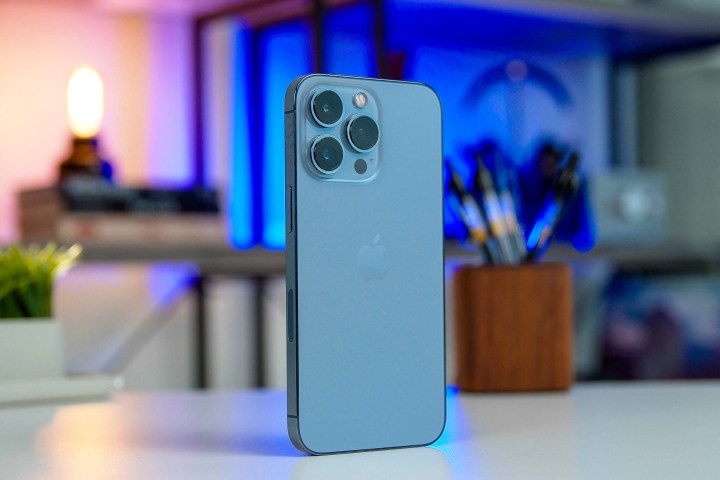
Dan Baker/Digital Trends
Apple iPhone 13 Pro
Best overall smartphone
Pros
- Packs lots of power into its size
- Incredible camera and video performance
- Very long-lasting battery
- Smooth and responsive 120Hz screen
- Comes with 1TB storage option
Cons
- No fast charging
- No USB-C
Why you should buy this: It’s the best smartphone around, with zippy performance, a great camera suite, and some gorgeous good looks.
Who it’s for: Anyone who wants the best smartphone money can buy.
Why we picked the iPhone 13 Pro:
If you’ve got the money, then the iPhone 13 Pro is absolutely the best smartphone around, and the device you should buy. Apple has pulled off another huge task, one-upping 2020’s iPhone 12 Pro and upsetting a legion of other smartphone manufacturers. With top-tier flagship power, a stunning display, an extremely long-lasting battery life, and one of the best cameras around, the iPhone 13 Pro is a triumph and the best smartphone you can buy.
We’ll start with the design because not much has changed here. The iPhone 12 Pro’s angular sides are still here, as is the stainless steel frame and range of gorgeous finishes. The notch is the largest design change made, though it’s still subtle. The new notch is slightly smaller, but also extends slightly deeper into the display, so doesn’t actually change much. Thankfully, the display it settles into is a stunner. The 6.1-inch Super Retina panel is clear and bright and finally uses the 120Hz ProMotion tech from the iPad Pro, making the performance seem even smoother and zippier.
It’s not just the display that makes the phone seem fast, because it is fast. Apple’s new A15 Bionic processor is extremely powerful and capable of handling anything you’ll throw at it. It’ll stay that way for years to come as well, thanks to Apple’s extremely solid update record, and with storage options starting at 128GB, you’ll have room for plenty of snaps and apps. The battery is excellent too, lasting for well over a day, with the possibility of lasting into a second day on light use.
The camera systems are, as we’ve come to expect, also excellent. The rear suite is comprised of three 12-megapixel lenses: A main wide-angle lens, a telephoto lens, and an ultrawide-angle lens. This trio is powerful and capable, providing strong color accuracy and plenty of detail. The telephoto lens also has a macro mode, which kicks in automatically, and shoots surprisingly good images.
The Apple iPhone 13 Pro is perhaps the best all-around smartphone you’ll find, though it doesn’t come cheap. Prices start from $999, but you can also find it on every major U.S. carrier, and from a big range of retailers too. 5G is also included, making this a strong future-proof option. Truly, the iPhone 13 Pro is the best smartphone you can buy right now.
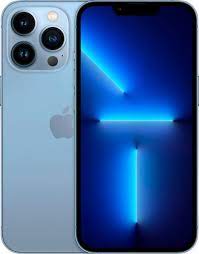
Apple iPhone 13 Pro
Best overall smartphone
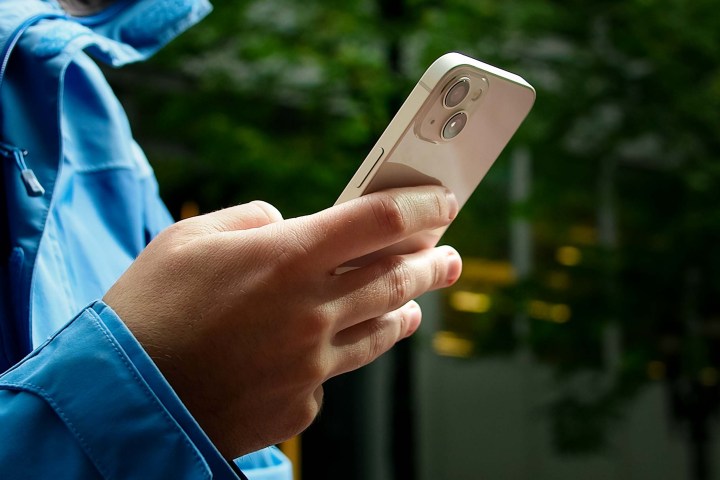
Dan Baker/Digital Trends
Apple iPhone 13
Runner-up best iPhone
Pros
- Fast and responsive performance
- Excellent camera and video capabilities
- Long-lasting battery life
- Supports most premium features
Cons
- Still no USB-C
- No higher refresh rate or telephoto lens
If the iPhone 13 Pro has one weakness, it might be that it isn’t as good a value prospect as the iPhone 13. While the iPhone 13 Pro is excellent, it isn’t actually that much better than its lower-priced sibling. At $799, the iPhone 13 offers much the same experience as the Pro version, with the same powerful A15 Bionic processor, 5G, a strong battery, and the latest iOS 15. It does miss out in a few areas, obviously. The frame is aluminum, rather than steel, and you’ll miss out on the telephoto lens and 120Hz as well. But if those features don’t tickle your fancy, then the chance to save $200 is one that’s hard to turn down.

Apple iPhone 13
Runner-up best iPhone
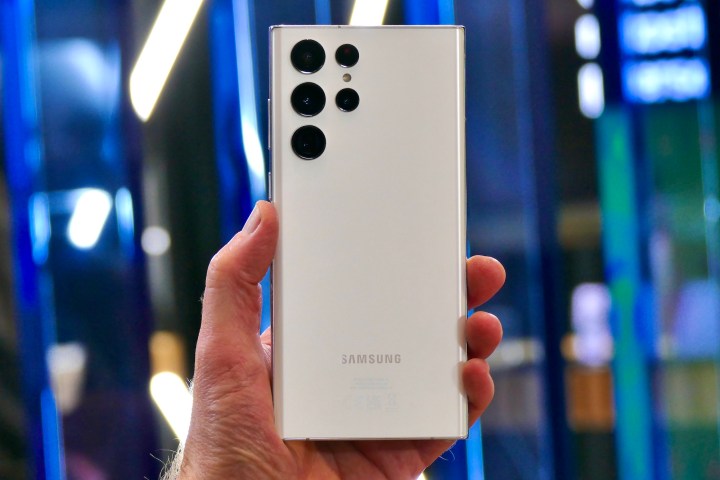
Andy Boxall/Digital Trends
Samsung Galaxy S22 Ultra
Best Android phone
Pros
- S Pen is convenient and highly accurate
- Versatile camera takes great photos
- The latest processor for power
- Long software support
- Beautiful high refresh rate screen
Cons
- Not very fast battery charging
- Large and heavy
Why you should buy this: It’s possibly Samsung’s best-ever phone, and the best Android phone around.
Who it’s for: Anyone looking for the best Android has to offer.
Why we picked the Samsung Galaxy S22 Ultra:
Put simply, it’s big, brilliant, and the best Android smartphone currently available. The largest of Samsung’s S22 series phones, what the S22 Ultra lacks in pocket-friendly credentials it more than makes up for with cutting-edge tech. True, it’s massive, but if you’re looking for one of the best smartphones you can buy today, it ticks all the boxes.
The demise of the Galaxy Note 20 Ultra left space for the S22 Ultra to step up as its sort-of replacement. Looks-wise, it takes its design inspiration from the Note 20 Ultra: Sleek yet all business, with its flush camera module, squared-off corners, and sharp lines. It’s also one of the heaviest smartphones around, weighing in at a hefty 228 grams — and it’s also not the best option for those who prefer to use their phone one-handed, at a chunky 9mm thick. It’s still a stunning phone though, with a matte finish that comes in a choice of five colors: Phantom Black, Phantom White, green, burgundy, and Pink Gold.
The 6.8-inch Dynamic AMOLED screen with 3088 x 1440 pixels and 120Hz refresh rate impresses from the start, covered in Gorilla Glass Victus+, with support for HDR 10+, and a peak brightness of 1,750 nits. This means everything looks stunning, even outdoors under the brightest sunlight.
Under the hood, the S22 Ultra packs the latest Qualcomm Snapdragon 8 Gen 1 processor in the U.S. (or the Exynos 2200 for those in the U.K. and the rest of Europe). You get 8GB or 12GB of RAM and 128GB or 256GB of storage space — but there’s no microSD card slot, so the storage you buy is all you’ll ever have. Nevertheless, those are some pretty powerful specs, which means this phone can handle anything you throw at it, from multi-tasking apps to the latest demanding games. The 5,000mAh battery will easily see you through a full day of heavy use or two days’ moderate use and Samsung’s added 45W fast charging too, though there’s no charger bundled in the box.
As you’d expect from the Galaxy-S range, the camera is impressive too, though it’s not a massive step up from the Galaxy S21 Ultra. You get a 108MP main lens, 10MP periscope zoom, 10MP telephoto, and 12MP ultrawide to the rear, plus a 40MP selfie camera. This time around, Samsung has improved the 3x, 10x, and 30x zoom, so you’ll notice greater detail and more accurate, natural colors. Notably, the main and wide-angle cameras provide pretty similar results to the S21 Ultra, though.
The S22 Ultra also has Samsung’s S Pen, previously found only with the Note series. Samsung has improved the S Pen, reducing the latency to 2.8 milliseconds, and the difference is really noticeable over the Galaxy Note 20 Ultra’s S Pen. For taking notes and sketching, it’s a joy, and when not in use it’s stored away in a special slot on the bottom of the phone. Add in Android 12 with Samsung OneUI 4.1, Samsung’s handy DeX mode, and an IP 68-rating for water resistance, and you have one of the best phones out there. If we had to say anything negative, it’s a behemoth of a phone, there’s no charger in the box (though this seems to be the norm nowadays), and there’s no microSD card slot. The Samsung Galaxy S22 Ultra starts at $1,200 from Samsung and is seriously worth the investment.

Samsung Galaxy S22 Ultra
Best Android phone
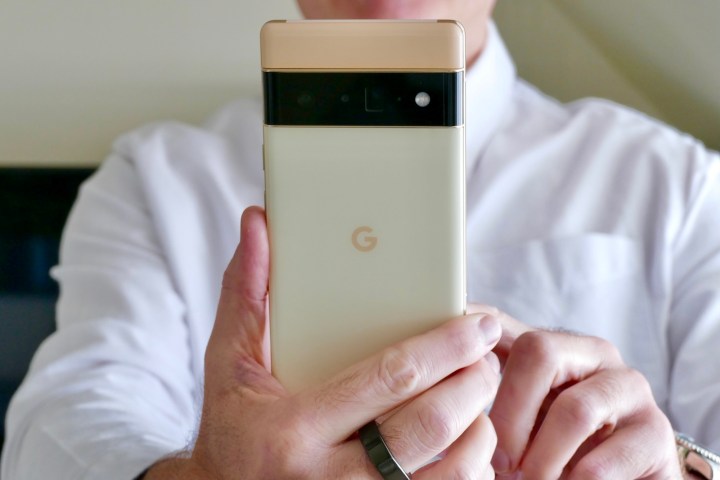
Andy Boxall/Digital Trends
Google Pixel 6 Pro
Runner-up best Android
Pros
- Incredible camera
- Fun camera features and editing tools
- Vibrant, colorful screen
- Android 12
- Long software support
Cons
- Unreliable in-display fingerprint sensor
- Flaky cellular connection in some situations
- 120Hz screen can jitter
Google is the only other major manufacturer that can exist in a similar space to Apple by offering smartphones intimately keyed into its operating system. That’s because Google creates and manages Android, so the Pixel series is always going to be the first device range to get access to the latest builds and updates of Android. But that’s not the only thing going for the Pixel 6 Pro. It’s exceptionally powerful, and — thanks to Google’s new Tensor chip — it boasts even stronger A.I. capabilities.
A great display and long software support are amongst its other advantages, but its strongest feature is its exceptional camera suite. The best camera phone around, the Pixel 6 Pro’s triple-lens camera suite takes some of the best still photos we’ve ever seen, and it’s beaten the Apple iPhone 13 Pro in a camera shootout. While the Galaxy S22 Ultra may have it down in terms of the pure number of features, the Pixel 6 Pro is an extremely good Android smartphone, and a worthy runner-up.

Google Pixel 6 Pro
Runner-up best Android

Erika Rawes/Digital Trends
Moto G Power (2022)
Best cheap smartphone
Pros
- Affordable
- Amazing battery life
- Accurate biometrics
- Decent amount of ROM
- Good camera system and software
- Water repellent
Cons
- No 5G connectivity
- Comes with Android 11
- Plastic backing
- Slow responses at times
Why you should buy this: The Moto G Power (2022) gives you all of the basics, in a good size, with unbeatable battery life.
Who it’s for: Budget-minded buyers that still want a big phone with great core features.
Why we picked the Moto G Power (2022)
When you’re on a budget but don’t want to miss out on features, Motorola is the answer. The brand has perfected the affordable smartphone, and the Moto G Power (2022) is an excellent buy for under $200.
Packing a huge 6.5-inch 90Hz display, 4GB of RAM, a MediaTek Helio G37 chip, and 64GB or 128GB of storage, it’s a bit of a downgrade on last year’s model, but you’re getting a massive 5,000mAh battery which can last up to five days with very light usage, more typically around three days.
With Android 11 out of the box, upgradable to Android 12, a 3.5mm audio jack that’s missing from many flagships nowadays, IP52 rating, and a decent camera setup — 50MP main, 2MP macro, 2MP depth sensor, and 8MP selfie camera — it’s easy to see why this is such a tempting option for under $200.
True, a lot of high-end features are absent. The body is plastic, the screen’s colors look a bit muted and dim, and you’ll likely notice lag if you’re creating content, multitasking for work, or playing the latest demanding games. There’s also no 5G or wireless charging. But for those looking for a great phone for everyday web browsing, emails, calls, and social media, the Moto G Power (2022) ticks all the boxes, at a highly affordable price.

Moto G Power (2022)
Best cheap smartphone
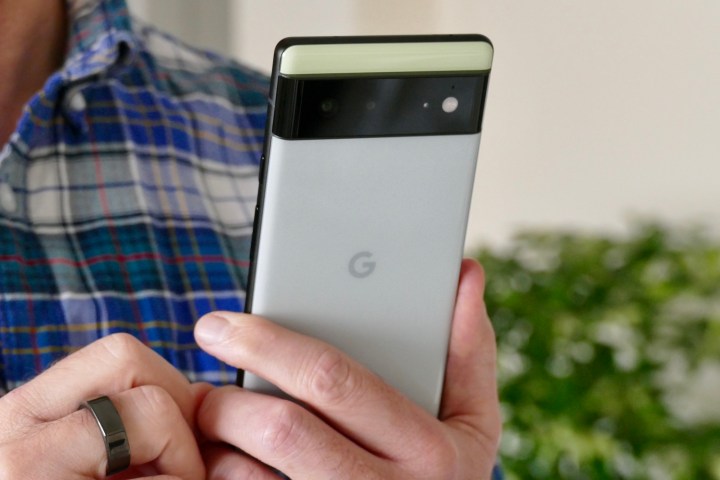
Andy Boxall/Digital Trends
Google Pixel 6
Best value
Pros
- Great camera
- Screen is colorful and vibrant
- Latest Android 12 software
- Years of software updates
Cons
- Flakey connectivity
- Fast charger not included
Why you should buy this: It’s a flagship-level smartphone with an incredible camera, at an unbeatable price.
Who it’s for: Someone who wants a powerful phone with a lot of update potential, for almost half the cost of a flagship phone.
Why we picked the Google Pixel 6:
We’ve highlighted the Pixel 6 Pro above as an excellent Android smartphone, but it’s the Google Pixel 6 that’s easily the best value for money you’ll find in a smartphone at the moment. The Pixel 6 shares the Pro model’s stunning design, exciting new hardware, a long-lasting battery, and a similarly excellent camera that won’t let you down.
The glass and metal body feels great to hold, and thanks to those materials, it feels substantial and weighty too. It is definitely on the larger side though, and so this definitely isn’t the phone for you if you want something smaller (check below for one of those). The 6.4-inch display has a 2400 x 1080 resolution and a 90Hz refresh rate, so it’ll feel smoother than a regular 60Hz display. The Pixel 6 Pro’s stutter is missing, which is good, and the fingerprint scanner is better too.
Google’s Tensor processor provides strong performance, and you’ll find a lot of strong AI-powered features, like Assistant Typing, as well as the newly upgraded Android 12, which brings the new Material You design to Android smartphones. It has 128GB of storage as standard, 5G connectivity, an IP68 rating for water and dust resistance, and years of Android updates.
The real jewel in the crown, though, is the camera. Like the Pixel 6 Pro, the Pixel 6 uses Google’s excellent software to tune the pictures you take and turn them into something truly special. Night mode shots are excellent, and Google’s enhanced digital zoom is good too. It’s not good enough to fully replace the missing telephoto lens from the Pixel 6 Pro, but it certainly helps. It’s not the best camera phone around, but it is very good, and great if you’re looking for a great phone with a great camera for everyday snaps.
So you get all of these top features, but how much for? There’s the really good part — the Google Pixel 6 starts from just $599. That’s almost half the price of the iPhone 13 Pro and with almost all of the same features, power, and photographic prowess.

Google Pixel 6
Best value
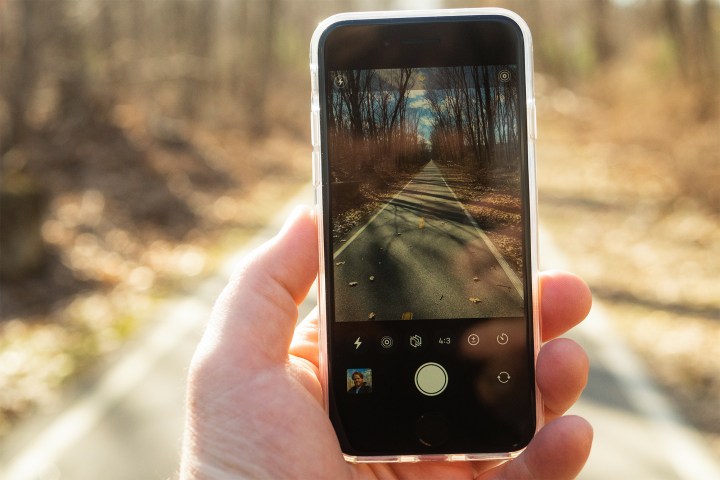
Apple iPhone SE (2022)
Best small smartphone
Pros
- Future-proof A15 Bionic chip
- Affordable price point
- Excellent image processing
- Compact form factor
Cons
- Dated bezels and design
- Unexciting LCD panel
Why you should buy this: Apple’s latest iPhone SE (2022) is a pint-sized wonder that’s powerful, affordable, and future-proof.
Who it’s for: Those looking for a future-proof phone that fits in their pocket (and their hand).
Why we picked the Apple iPhone SE (2022)
Finding a truly small phone today feels like hunting for a needle in a haystack, but the iPhone SE (2022) is really, truly small, with its tiny 4.7-inch Liquid Retina display with 60Hz refresh rate. Sadly, the design feels a bit dated, cribbing the iPhone 8’s design, with chunky bezels and a Home button with integrated Touch ID.
Looking beyond its size, there’s a lot going for the new iPhone SE. Under the hood, you’re getting Apple’s latest A15 Bionic chip with the same performance spec as the iPhone 13 Pro. There’s also 4GB of RAM, 64GB, 128GB, or 256GB of storage, and a decent battery, though heavy use may see you struggle to make it through the day with much left in the tank. You’ll be up and running fairly quickly with 18W fast charging and Qi wireless charging.
You also get a single 12MP rear sensor and 7MP selfie camera, identical to the previous iPhone SE. But it’s Apple’s software that makes a difference here, with Deep Fusion technology, Smart HDR 4, and Photographic Styles, as well as improved Portrait Mode. There’s no Night Mode though, so shooting in low-light environments can be a challenge.
Add 5G connectivity, iOS 15 out of the box, and five or six years of OS updates, and it’s easy to see why the new iPhone SE (2022) is our best small smartphone. Yes, the design feels a bit old-fashioned, those bezels are pretty clunky, and there’s no charger in the box — but now we’re nitpicking. The new iPhone SE (2022) comes priced at an incredible $429, so you won’t need to break the bank to afford it.

Apple iPhone SE (2022)
Best small smartphone
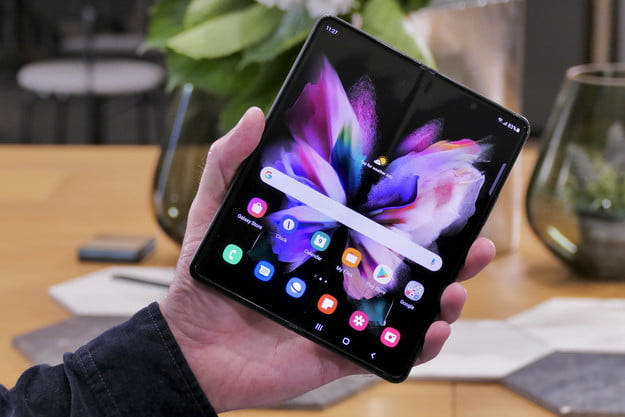
Andy Boxall/Digital Trends
Samsung Galaxy Z Fold 3
Best foldable smartphone
Pros
- Improved screen durability and IPX8 waterproofing
- Powerful hardware and capabilities
- Solid rear cameras
- Great for multitasking and productivity
Cons
- Still expensive
- Lackluster battery life
Why you should buy this: Folding phones are finally ready for the big time, and the Z Fold 3 is the biggest and the best folding phone around.
Who it’s for: Anyone who wants to sample the future, and wants a great smartphone to boot.
Why we picked the Samsung Galaxy Z Fold 3:
Love the idea of carrying a tablet around in your pocket? Have we got the phone for you. It has taken until the third generation of foldables for Samsung to really crack it, but it really got it right this time. The Galaxy Z Fold 3 isn’t just a great folding phone, it’s a great smartphone in its own right, and one we have no hesitation in recommending if you want a foldable phone.
Let’s cover the biggest reason you’ll want one first — the two screens. The outer display is a 6.2-inch AMOLED screen, and it’s very much like using and handling a normal phone, except for the additional thickness. But open it up and you’re treated to a massive 7.6-inch display that’s roughly the same size as that of a Kindle Paperwhite. It’s a veritable tablet screen hiding within your smartphone, and it’s really, really cool.
Really, if you’re looking for a big folding phone, this is about all you need to hear. But there is more. It’s now IPX8-rated for water resistance, so it can take a short dunking, and there’s an improved hinge system to stop dust and particles from causing damage to the mechanism. It’s powered by the Snapdragon 888 and has 12GB of RAM and 256GB of storage as standard. It’s a real powerhouse, and it wants you to use that extra screen real estate to get some serious work done. Or just watch cat videos and play Pokémon Unite, whatever you prefer.
Of course, the future doesn’t come cheap and you’re looking at a major investment to get your hands on a Galaxy Z Fold 3. The starting price is around $1,400 That’s over double the cost of a Pixel 6, just to give some more context. That’s a lot of dollars, but if your heart is set on getting a hold of the future, then it doesn’t come better than the Samsung Galaxy Z Fold 3.
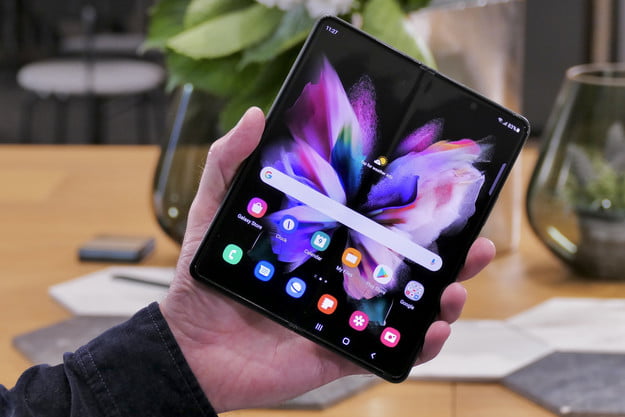
Samsung Galaxy Z Fold 3
Best foldable smartphone
Frequently Asked Questions
What is an unlocked smartphone?
A locked smartphone is tied to a specific carrier’s network, so if your phone is locked to Verizon, for example, you can only use it with a Verizon SIM and service plan. An unlocked smartphone can be used on any network. If you’ve paid in full for your phone, then it should be free to unlock. We have a guide that will show you how to unlock a phone on every carrier. You can also buy some great unlocked phones that will work with any carrier straight out of the box.
Can smartphones get viruses?
While it is possible to get viruses on iPhones or Android phones, what most people mean when they say “virus” is malware. Technically, the term virus means software that infects a host, inserts itself into an existing program, and then spreads that infection by self-replicating. They are a very small percentage of malware and extremely rare on smartphones, but malware isn’t. You should definitely think about how to protect your smartphone from hackers because a little common sense can save you from having to work out how to remove malware from your phone.
What should I do with my old smartphone?
The most obvious thing to do with your old smartphone is to pass it on to someone else. If you want to gift it, then make sure to wipe it first; we have guides on how to wipe your Android phone and how to factory reset an iPhone. You may also want to turn that old phone into cash, in which case you’ll want to read up on how to sell your smartphone. You may decide to keep it as a spare in case your new smartphone breaks, but you could also repurpose it with the right apps. It’s better to pass it on to someone who can use it or find another use for it than let it languish in a drawer. If you can’t think of a good way to reuse your smartphone then consider donating it or recycling it.
How long should a smartphone last?
Realistically, you should expect to get two to three years out of your smartphone. You can extend the life of any smartphone by taking proper care of it and it’s always worth shopping for good protective cases. There are also loads of good waterproof phones to choose from nowadays. The problem with many Android phones is that the manufacturers and carriers are slow to push out software updates, so the software can become dated and even insecure over time. With that said, Samsung recently set new standards for updates, promising four OS updates and five years of security updates on select Galaxy devices including the Galaxy S22 series, Z Fold 3, and Z Flip 3. Apple is also known for its lengthy updates promise, while Google offers three years of Android OS updates and security updates for the Pixel 6 and Pixel 6 Pro.
Do phones cause cancer?
The question of whether cell phone radiation is dangerous is still hotly contested in some quarters. It is technically classified as “possibly carcinogenic to humans” but that puts it in the same category as coffee, gasoline, and nickel. There have been many studies, but we still lack any scientific evidence to provide a definite answer to the question one way or the other. Most official bodies, including the Federal Communications Commission, Center for Disease Control, and National Cancer Institute agree there’s no proven link right now, but also acknowledge that we need more research.
How do prepaid phones work?
Prepaid cell phones work just like any other phone, but they come without a monthly contract or long-term commitment. You usually pay for service in advance. When you buy a prepaid phone they tend to come with a fixed number of minutes, text messages, and possibly a fixed amount of mobile data. This removes the chance of any overage charges. When you run out, you simply top up by buying more minutes, texts, and data in chunks.
Which operating system is best for you?
This is where things get personal. Picking a smartphone operating system is a huge deal. You’re buying into an entire ecosystem of apps and compatible products when you choose between Android and iOS.
Apple’s iOS is beautiful, simple, and easy to use, and the App Store offers the best app selection imaginable. Every aspect of iOS is curated by Apple, and it shows. Android is more open and it has fewer rules, which means more customization options, but it also means that manufacturers and app makers can willfully ignore Google’s Material design language and do whatever they want, sometimes rendering Android unrecognizable and cluttered. Android is gorgeous, as seen on Google’s Pixel 6 and Pixel 6 Pro, but you don’t always see it like that.
Since Apple is the only company that makes iPhones, it also has complete control over software updates. As such, iPhone owners always get the most recent and best iOS experience possible. Android users don’t have that luxury. Unless you own a Pixel device — and fairly few Android users do — you may have to wait months to get software updates.
Software updates contain security fixes, which keep your phone safe from malware, viruses, and hackers. Android is the most heavily targeted mobile operating system because it’s far and away the largest, so this is something you have to keep in mind when considering phones from companies that have a less-than-stellar track record of releasing updates.
In contrast, Apple can patch security flaws and send the updated software to all iPhone users immediately. Since most users update their software when prompted, most iOS users are protected from these very real threats. Apple’s iOS also offers full encryption with no compromises.
If you still haven’t found what you’re looking for, then we also have ideas about the best rugged phones, best phones for kids, and the best gaming phones.
How we test
A phone is so much more than its spec sheet. Your entire life is stored on it, from your photos and contacts to your music and your favorite apps. For that reason, we take great care when we review phones to recommend only the absolute best out there.
We use each phone we review as our daily driver for an extended period to test out all the features. We do benchmarks, play games, take photos, plunge them in water, and use them until their batteries expire. Then we charge ’em up and do it all over again. We test devices like real people use devices. We’re not in some stuffy lab performing obscure tests. We’re running around the cities we live in using these phones just like you use your phones. Then we think about each phone in comparison with its competitors to come to a decision: Should you buy this phone or something else? If the answer is “something else,” we tell you what to buy instead.
Smartphone innovation has peaked, and the number of radical new features that come out each year is shrinking. As such, when you’re buying a phone, you’re buying a device that will be with you 24/7 for several years. It’s a big choice, and things like apps, a product ecosystem, customer support, and security should be important factors in your buying decision.
Editors’ Recommendations




